#i use excel in the most primitive form
Explore tagged Tumblr posts
Text
hey do y'all know of somewhere i could learn about excel and how to properly use it??? i feel like if i learned the basics i would use it all the time but it's very daunting to me rn. also i don't know how well places like coursera or skillshare are, i don't know if they're more scam than actual places to learn stuff
#any help is appreciated!#i use excel in the most primitive form#but i know given my love for lists and data i would love using it if i didn't have to look up how to do x thing every time i want to
9 notes
·
View notes
Text
It's big, it's strong, its scaly, it's this week's Wet Beast Wednesday topic! An arapaima, also known as a pirarucu or paiche, is any of four species of fish in the genus Arapaima in the order of bony-tongued fish. There is som ongoing debate about the classification of the species, so to keep thing simple, I'm going to use the most common species names of Arapaima gigas (the type species and most well known, and the one with the most confusion about its classification), Arapaima agassizii, Arapaima leptosoma, and Arapaima mapae. Because A. gigas is the most well-studied of the species, unless I say otherwise you can assume everything I say in this post applies to it.

(image: an arapaima)
Arapaimas are bony fish that retain several primitive traits, causing them to sometimes be identified as "living fossils". They are most notable for their size, with A. gigas being a contender for the largest freshwater fish in the world. The maximum recorded size for one was 3.7 meters (10 ft) and 200 kg (400 lbs), but most get to around 2 meters (6.6 ft) long and 200 kg (440 lbs). That average length is decreasing as overfishing of the largest individuals is resulting in a selective pressure for smaller sizes. In addition to their size, they are extremely strong and can move fast if needed. Arapaima are fully capable of leaping out of the water if disturbed or they feel their current pond in unsuitable. Because of their strength, specimens in captivity must be handled with care as they can easy break bones if they slap someone. They live in rivers and lakes in South America, where they are often the top predators.
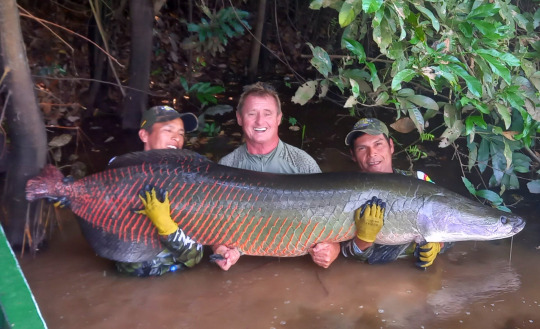
(image: several anglers with an arapaima)
Arapaimas are obligate air-breathers and will drown if they can't get to the surface to breathe. This is accomplished with a specialized swim bladder. The swim bladder is filled with highly vascularized tissue, letting it act like a lung. This pseudo-lung opens into the mouth using a modified gill arch known as the labyrinth organ. Arapaima gills are too small to sustain them, but they can supplement their oxygen intake with the gills. Juveniles are born exclusively using their gills and transition into air-breathers shortly after hatching. Arapaimas can survive up to a full day out of the water. They typically surface to gulp in air every 15-20 minutes. Breathing makes a loud gulping sound that anglers use to target them.

(image: an arapaima at the surface)
Because of their ability to breathe air, arapaimas are top predators in low-oxygen environments. Non-air breathing fish are forced to slow down in water with low levels of dissolved oxygen as they can't get enough oxygen through their gills. Since Arapaimas breathe air, they can easily chase down lethargic smaller fish. They are especially potent predators during the low season, when water levels lower. A combination of rotting vegetation reducing oxygen levels and ponds getting cut off from rivers and losing a supply of oxygen lets the arapaima reign supreme. Arapaimas are primarily predators that feed on smaller fish, though they will hunt other types of animals and eat fruits and seeds. Even land animals aren't safe as arapaimas have been known to launch themselves out of the water to catch animals near the shore. A combination of sharp teeth and their bony tongues are used to debilitate prey.
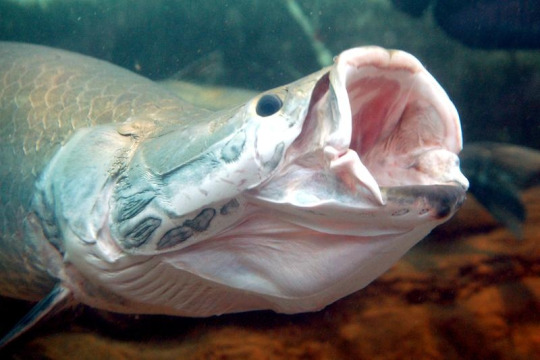
(image: an arapaima with its mouth open)
Not content with powerleveling their attack stat, arapaimas also have excellent defense. Their scales have been compared to bullet proof vests. Each has a hard, mineralized outer layer over multiple layers of collagen fibers. These layers are all oriented at an angle to each other to provide extra strength. This orientation of layers is called a Bouligand-type arrangement and is similar to how plywood is assembled. The harder outer layers and flexible inner layers work together to allow for both strength and flexibility. These scales help provide protection form large predators such as caiman and small threats like biting piranha. They also like provide protection from other arapaima, as the fish are aggressive and will fight each other.

(image: a diagram showing the composition of arapaima scales. source)
You probably wouldn't expect a swimming tank of an animal to be a good parent, but you'd be wrong. Arapaimas work together in mated pairs to build nests for their eggs, then cooperate to guard the nest. Once the eggs hatch, the male will practice mouth brooding, keeping his young safe in his mouth. The female will also help by patrolling the area around the male to ward off predators. They secrete pheromones from their heads to ensure the young don't swim too far away. Eggs are laid either in in the low season or as water levels are starting to rise, ensuring that the young become independent during the high season.
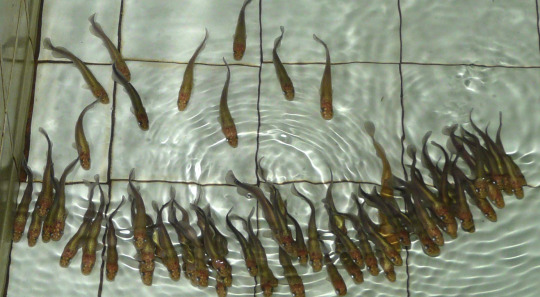
(Image: baby arapaimas)
Arapaima are classified as "data deficient" by the IUCN. This means there isn't enough data to properly assess their conservation needs. They are known to be threatened by overfishing. Arapaima make up a large part of the diet of many South American populations. Habitat loss and pollution are also believed to threaten them. They have been introduced to many areas out of their native range and are an invasive species in placed like Florida, Malaysia, and India.
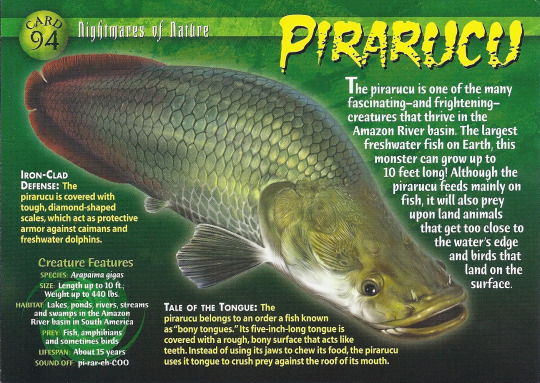
Does anyone else remember these cards? (image: the arapaima card from Weird n' Wild Creatures)
#wet beast wednesday#fishblr#fish#biology#zoology#ecology#animals#aquatic biology#animal facts#absolute unit#arapaima#pirarucu#paiche
1K notes
·
View notes
Text

I’m playing Silent Hill 2 and while reading the walkthrough, I found a very interesting explanation to one of the puzzles, involving certain symbology.
The author of the article has no affiliation with astrology and so they identified the symbols as Alchemical, which they are, but what they weren’t aware of is their spiritual significance. As an Astrologer, I took notice of it immediately and was intrigued, because the explanation gives excellent background for possible planetary remediation linked to natural metals associated with planets.
I’m gonna skip vitriol and philosopher’s stone and move right to the planets.
The first one on the list is Saturn, being associated with lead. That is an intriguing piece of information, giving the fact that lead is something people are trying to get rid of and purify themselves from in their lives for the sake of health, as well as it’s the material used to produce bullets or chains, both associated with death or imprisonment. It’s a heavy material, associated with all those difficult karmic things like bondage or disease. On the plus side, it is also used for protection from danger, such as radiation shielding or excessive sound isolation. If you’re struggling with ego and need to humble yourself, or feel like you need to be isolated from external stimuli,this metal may be excellent for spiritual purposes.
The second symbol on the list is Jupiter, associated with tin. That is such a curious association, given that tin is put on cans to protect our food from corroded metal, and Jupiter rules protection and nourishment. The metal was used historically for variety of purposes, and if you research it you will see how wide its usefulness spreads. In appropriate form and small quantities, it’s even safe to ingest, again giving it that Jupiter connotation.
The next symbol is Mars, linked with iron. Iron is the cheapest, most basic but also the most universal metal for tool production, and fits perfectly with Mars’ simple logical tool usage. It’s almost primitive, yet so functional and practical, as our ancestors knew.
I’m going to lump the Sun and the Moon together, because it is a widely known fact of astrology that as the king and the queen they both rule the most precious metals, gold and silver respectively.
Venus’ ties to copper are also well known in spiritual circles, which is why copper is used in high quality cooking apparel but also as a healing metal, known for balancing the body as per Venus’ physical school of healing.
Mercury, which after all has a metal named after itself, the only liquid metal on the list, or at least commonly used in liquid form. That association further exemplifies Mercury’s ties to healing and the caduceus symbol, as Mercury is the metal used in traditional old style thermometers. Mercury, however, is dangerous to approach directly and toxic to the touch without specialized protection. Mercury is also commonly used in electricity as a conductor, and interestingly enough, in gold extraction, which is mythologically accurate, Mercury being the envoy of the Sun, the king himself. People with very strong Mercuries may like to work in professions requiring contact with wires or chemicals.
#astrology#vedic astrology#jyotish#astro observations#astro notes#vedic astro observations#vedic astro notes
36 notes
·
View notes
Text
The myth of Apollo (6)
On to complete this little series I never had time to finish! As with my "The myth of Dionysos" series, I will end my loose translations with the section dedicated to Apollo in Félix Guirand's "Mythologie générale" (General mythology). As I said before, it was from the late 30s originally, so it is a bit old and some info might be outdated, but it was the dominant compendium for most of the 20th century, so it completes quite well the previous and more modern articles I shared before.

I/ Origins, traits and attributes
The etymology of the name « Apollon » is uncertain. None of those that were submitted are satisfying, be it its link to the old Greek verb “apello”, meaning “to push away, to repel”, or a potential tie to an ancient form of “apollumi/apollymi”, “to destroy” (Apollo “the destroyer” would be how he appears in The Iliad). Some even go as far as to try to link it to the English “apple” to make Apollo a primitive god of the apple-tree…
We are just as unsure when it comes to the god’s origins. Some think he comes from Asia: either he is a Hittite god, a double of the Arabian deity Hobal ; either he is a god from Lycia. Other meanwhile use Apollo’s close relationship to the Hyperborean to show him as a Nordic god, brought by the Greeks from Northern Europe during their migration. It is hard to choose between those opposite theories because each of them brings interesting and plausible ideas, while not actually presenting solid proof.
It must be said that the legend of Apollo is so diverging that it sometimes confines the myth into pure contradiction. For example, this deity which was the Greek god by excellence and the essence of Ancient Greece, somehow sides with the Trojan (aka, Asians) in The Iliad. And if we accept that Apollo comes from Asia, then why are his retreats identified as the Tempi Valley and Hyperborea, implied to be his native land? As for his attributes, they are so multiple and complex it is often hard to link them together.
Apollo is first and foremost a god of light, and a solar god – without actually personifying the celestial body itself, as the sun was identified with the specific god that is Helios. But as a light go he was called “Phoïbos”, “The Shining One/Bright One”, Xanthos “The Blond”, “Chrysocomès”, “Of gold hair”. He was said to enjoy most of all “high places”, the highest mountaintops and the promontories overseen the waters. It makes sense that this solar god would be the son of Leto, known by the Romans as Latone ; a deity who was very likely a night-goddess, and the double of the Asian Lada. As a solar god, Apollo is the one who helps fruits grow out of the earth, and this is why the first harvest was dedicated to him in Delos and Delphi. He was also a harvest-protector by destroying the rats that infested the fields (Apollo Smintheus) and repelling locusts (Apollo Parnopion). However, since the sun is also a murderous power whose rays were said to hit like shots, Apollo was seen as an archer god who threw far, far away his arrows (Hécatébolos) that caused sudden death. But, since the sun is also a benevolent power causing purification, Apollo was also the healer god that pushed away evil (Alexicacos). In this latter function, he seems to have replaced a more primitive Greek god known as Paeon (The Healer) and whose name is linked to the character of Paeéon that Homer names “the physicists of the gods”.
Apollo was also a god of divination and prophecy. Outside of the numerous oracles he owned in Asia Minor, Thymbra, Claros, Gryneium and Didymos, Apollo had sanctuaries all throughout Greece where people went to seek his council, as the god spoke there through his intermediaries, the Sibyl priestesses. Some famous examples of these sanctuaries were those of Tegyra and Thebes – in the Theban sanctuary, the Sibyl was none other than the daughter of Tiresias, Manto. Still in Thebes, by Pausanias’ time, one could find the stone on which Apollo’s priestesses stood to give his oracles, called “Manto’s seat”. This stone was later sent to Asia Minor, to create the Claros oracle. But of all the sanctuaries of Apollo, the most famous was of course Delphi, located in a deep grotto from which came out “prophetic vapors”. The priestess, called a Pythia, sat on a tripod at the entrance of the cave. Soon, under the influence of the god, she entered into a state of trance and, possessed by a “prophetic delirium”, she said fragmented and obscure sentences, interpreted in turn by the male priests of Apollo and by the members of the sacred council of Delphi. To give the power of divination to a solar god can be surprising, because in Ancient Greece prophecies usually were reserved to chthonian deities. And yet, Apollo ended up eclipsing all of those earthly oracles – as such, we have to consider that Apollo must have had his oracular powers before he entered Greece. This makes him very similar to the Assyro-Babylonian god Shamash, a sun god who has the power of divination ; and it would confirm the Asian origin of Apollo.
But outside of these facets of the solar god, Apollo has many, many other domains. Apollo was a shepherd/pastor god (Nomios) in charge of protecting herds and flocks. His epithet “Lycian”, if it isn’t simply an indication that he comes from Lycia, had been linked to some to the root “lux” of the Latin word “lux”, light – confirming the solar nature of the god. However, “Lycian”, in Greek “luxeioz”, is also linked to the word “luxoz”, “wolf”. Apollo might have been originally a wolf-god, or maybe simply a wolf-killer as his nickname “Lucoctonos” confirms. This all indicates a rural deity, which is to link to the way Dorians celebrated Apollo as a pastoral god called “Apollon Carneios” (Ram-Apollo). On top of this, Apollo was also the god of singing and of the lyre – this is how Homer painted him to us, as all the gods listening the beautiful melodies Apollo creates on his cithara. Apollo, finally, is a builder god and a colonizing god, who is said to “enjoy the building of cities, of which he always establishes the foundations”.
These many attributes lead one to believe that Apollo is actually the conflicting of several different personalities, and that he started out as an Asian solar god which, when brought over to Greece, was conflicted with a rural norther Greek god, the Apollo Nomios/Ram-Apollo of the Dorians.

II/ Depictions
Despite his multiplicity, Apollo always kept the same appearance. He was depicted as a young man of ideal beauty, with a strong body, a broad chest for narrow hips. His face was beardless and delicate, his high forehead crowned with thick and long hair, sometimes floating onto his back, sometimes tied into a knot with only a few curls falling on his shoulders. He was usually naked, or wore at most a chlamys. When depicted as a musician-god, he usually wears a long tunic with large folds. His attributes are the bow and the quiver, the shepherd’s crook and cithara. His dedicated animals were the swan, the vulture, the raven, the falcon, the cicada, the wolf and the snake. His favorite plants ere the laurel, the palm-tree, the olive-tree, and the tamaris.

III/ Birth of Apollo
According to the most ancient traditions, Apollo’s mother, Leto daughter of Coeos and Phoebe, was a wife of Zeus whose relationship with him was anterior to his marriage with Hera. It is as a former wife of Zeus that she appears in The Iliad, where she and her son protect the Trojans (probably due to their Asiatic origins). Hesiod also depicts her as such, adding that she wears a dark-veil, which seems a fitting outfit for a night goddess. It was only later that Leto became a mistress of Zeus faced with Hera’s jealousy – and the conflict between these two goddesses forms the main part of Leto’s legend.
When Leto, pregnant with Zeus, sensed she would soon start her labor, she went looking for a place perfect to deliver her babies. However, furious and jealous, Hera hunted her down, and forced her to cross Attica, Euboea, Thrace and the islands of the Aegean Sea. Leto kept asking each region, island and land if they wanted to welcome her, but all, fearing Hera’s wrath, refused. Hopefully Leto encountered the floating island of Ortygia, which was the final form of Leto’s sister, Asteria, which had turned into this landmass to avoid the lust of Zeus. Leto promised to Ortygia that, on its rocky and sterile ground, Apollo would build a splendid temple, and this gift had the island agree to welcome Leto. But Hera had made an oath that her rival would never give birth in a land touched by the rays of the sun ; to go around this restriction, Poseidon created a dome that he used to cover the island, and maintained by four pillars at the bottom of the sea. After the birth of Apollo, Ortygia’s name was changed into Delos, “The Shining One”.
When Hera realized she could not prevent the birth, she decided to slow it down as much as possible: while all the goddesses had come to Leto’s side to help her, Hera maintained by her side Ilithyia, the goddess of childbirth, forbidding her to go to Leto. During nine days and nine nights Leto suffered the pain of labor without being able to deliver her babies. Finally, Iris, sent to Olympos, managed to bring back Ilithyia. Finally, Leto gave birth to Apollo as all the goddesses screamed with joy, and the female Immortals washed young Phoïbos with pure water and wrapped him around in a white veil, closed by a golden belt (according to the Homeric Hymn to Apollo). At the same time, Leto also gave birth to a daughter, Artemis. (Sometimes, due to the similarity of names, Apollo’s birthplace was not identified as the Delos island, but as the Ortygia sacred wood, near Ephesus). Apollo’s birth, unfortunately, did not end Leto’s torment. Out of fear of Hera she had to flee Delos and hide in Asia Minor, in the Termite Land, later known as Lycia. One day there, as she came near a pond, she tried to drink its water – wicked shepherds prevented her to do so and soiled the water. Leto, as a punishment, turned them into frogs.

IV/ Apollo’s childhood; the Python snake
Apollo was not nursed by his mother’s milk ; instead he was fed by Themis with ambrosia and nectar. As soon as he consumed those products, Apollo threw away the cloth that wrapped him and gained a manly strength, which he immediately used to kill the snake Python. Python was a female dragon that had been birth by the Earth (Gaia) to act as Typhon’s nurse. Hera, who wanted to destroy her rival at all costs, had sent Python to track down Leto when she was about to give birth to Apollo ; hopefully, Poseidon had hidden Leto’s resting place in the waters, meaning Python, unable to find its victim, had to return to its lair on the wooden slopes of Parnassus.
Four days after his birth, Apollo went out in the world, in search of a land where to build his sanctuary. Armed with arrows that Hephaestus had forged for him, he went down from Olympus, crossed Pieria, Euboea and Boeotia, before finally reaching the Crissa valley. The nymph who ruled over this valley, Telphusa, wanted to keep her sole power over the region and so she treacherously advised Apollo to go into the wild gorge of the Parnassus where Python dwelt. When Python saw the god, it attacked, but the young deity killed it with its arrows, in a very long, agonizing, painful death. Once the body stropped writhing and rolling around, Apollo pushed it away disdainfully with his feet, saying “Rot now where you are”. In memory of this battle, the place came to be known as “Pytho” (from the Greek “puthein/pythein”, “to rot”), later changed into the name “Delphi”. As for Telphusa, the god punished her treachery by smothering her under a rock.
In order to purify himself from the soiling that the murder of Python had caused, Apollo exiled himself in Thessaly, in the Tempi Valley. Once the time of expiation for his crime was done, he returned to Delphi crowned with sacred laurel, with an entire cohort of priests who sang triumphant hymns. These events were celebrated at Delphi by the festival of “Septeria”, or the feast of celebration, organized every nine years. A teenager chosen among nobility was playing Apollo. Helped by other young men, he set fire to a wooden cabin meant to symbolize the house of the dragon. At the end of the Septeria, the same young men had to go on a pilgrimage to the Tempe Valley, where they performed expiation rituals, before returning to Delphi bearing sacred laurel.

35 notes
·
View notes
Text
Road to countryside - about a countryside and a summer
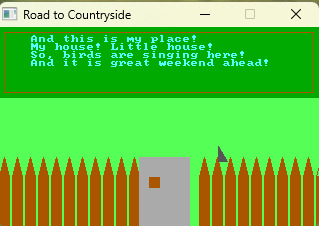
Summer. Such a good time. Sun. Excellent weather. There are lots of green around. Grass. And trees. There are lots of beautiful flowers. It is very beautiful and super positive time of the year! Especially, if to decide to go to countryside. And, at the countryside - there are lots of countryside things to do!
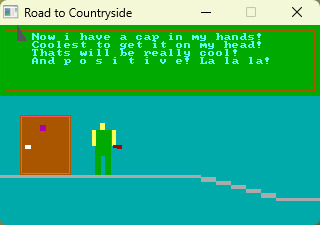
There are forest and field, they are waiting for you! Waiting - and cannot wait! And, also, there are river and a lake! You can go to a swamp, it is so green and it is, also, an interesting place! It happens, that everything is grown up with grass at the countryside place. And, it happens, that there are not too much grass there. So, there are lots of things to do at the countryside place!
youtube
And, this is a game about a countryside! About a road to the countryside. About a positive mood. With a form of point and click quest. There are pictures. And, you click at the objects at the picture. You need to find a certain items. And click at them. And, this way you will go to next picture. There will be little of text with description of a picture and what you need to do!

And you are at first scene, for example. It is your room. And here before you - there is table, chair, bed. Some books are here. And, you need to take ball, bag, and keys. You need to find this items using mouse, and as you find – do a mouse click. At this moment - you see a text at the top. You take item! You take keys. For example.

Visual side of the game – it is retro style. Ms Dos. Something like, CGA graphics, 16 colors. Everything is drawn with primitives, such as circle, square, line. And painted with a certain color.
Today, all game is programmed at the level of gameplay itself. It is 19 game scenes. At them you need to find, in a middle value, three items. To move next. Sometimes, one item. And, everything is drawn. But in main idea view. So, it is still ahead to draw the details. There is no details at the pictures. So, I continue to draw. To make picture better!

There are 19 game scenes in game. About how you are going to a countryside. You take keys, all the things. Go to bus. Ride by train. In train you listen player. While train goes.

Road - it is a big thing. It is long time process. And it requires some patience. So, you are listening music in the road. With your cassette player. You have a cassettes with rock and pop music. And you can to select what you will to listen. So, you are going by train and listen player! Beautiful! You move cassette this and that!
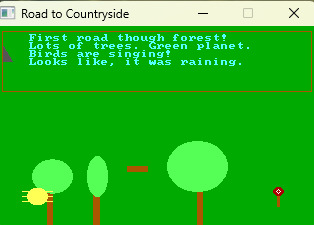
Later, you go to a station and go by forest. There you collect beautiful little flowers, even, a bug to take with yourself. Later, you put little flowers at your countryside place. And, let bug to run at your place!
Next, you go by field. And, also, collect little flowers. Later, you go across country houses. And collect useful items. For example, gear. So, it is a quest. To click mouse you need, and to read what to do next.
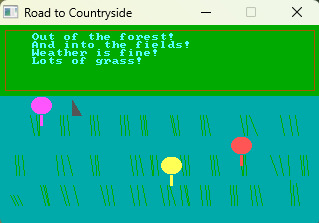
It is a new theme for a game - quest. Work with mouse. It is programming with well known programming language QB64. It is everything done good there. And there are no problems. Built in functions.
So, I want to share my own countryside memories too. So, I remember, I go by train and listen player. Alice Cooper, for example. Several times I listen an album during road to the countryside, And same thing for road back – to the city.

Or you go by country place, and there - it is was a little raining, few moments ago. And now - there is no rain. But it was few seconds before. And, all grass is in water. It is also a cool thing! Everything is so refreshing!

Basic Pascal version 1.17 "BLOCK" – most newest version. In this version there are 4 new games! Platform Ball, Cabin Pilot, Free Blocker, Free Bee. And even more retro games! It is a pack of retro games with modern versions of Basic and Pascal.
It is now in development new version Basic Pascal pack games. This game will be included in a new version.
Basic Pascal: http://www.dimalink.tv-games.ru/packs/basicpascal/index_eng.html Website: http://www.dimalink.tv-games.ru/home_eng.html Itchio: https://dimalink.itch.io/basic-pascal
#retro game#quest#adventure#ms dos#8 bit computers#8 bit#cga graphics#summer#sun#countryhouse#point and click#search items#funny pictures#road to countryside#train#bus#grass#field#music#relax#positive mood#countryside#country house#village#road#gamedev#devlog#80s#Youtube
7 notes
·
View notes
Text
The Ibizan Hound
For National Purebred Dog Day and Day of the Podenco (May 1st) please enjoy this write up I recently did on the Ibizan Hound (aka Podenco Ibicenco).
Please keep in mind that I am U.S. based, so most of my information is going to be about the community and sports here in the United States.
The beginning of the Ibizan Hound, like many primitive breeds, cannot be narrowed down to a specific set of dates or even years. Like many other Mediterranean and Middle Eastern breeds, fanciers like to compare Ibizan profiles to those of dogs found in hieroglyphs and on statues and imagine their ancestors being those who lived among the Ancient Egyptians. Then, at some point, they were said to be brought over to the island of Ibiza on trade ships. Recent genetic testing does not quite support this story, but what can't be denied is this - Ibizan Hounds have been uniquely selected and adapted over hundreds of years to hunt rabbit through the brush-filled, rocky embankments and hot, arid climate of Ibiza.
Ibizans are pack hunters - first using their eyes, ears, noses, and innate curiosity to investigate the area and find anything attempting to hide in briars or other natural formations. A bark, a wagging tail raised over the back, and an excitement for the future chase alert the other dogs and the human hunters to the prey's location, where the dogs will congregate, flush the prey from it's hideout, and hope for a quick catch. But, if the rabbit is clever enough to avoid immediate doom, the chase gives way over the harsh landscape. This is where the Ibizan's unique conformation comes in. Their front is intentionally forward set and has more elasticity than most breeds, giving them the ability to maneuver, rotate, and change direction mid-air. Combined with lithe, flat muscling, their medium size, incredible leaping prowess, and fear of nothing in the face of the hunt, most Ibizans have the drive and ability to go over, under, around, or through any natural obstacle they may find in their path. Ibizan Hounds are an excellent example of form follows function in that everything, from the ears on their head down to the tips of their tails, has been fashioned to help them excel at their purpose over the years of selection for the best hunters.
In the United States today, Ibizans have been recognized in the Hound Group by the AKC since 1978. Officially, the standard calls for females to be 22.5-26" and males 23.5-27.5", though small deviances in either direction shouldn't be held against a dog who is otherwise a nice example of the breed. With this height range, you can find dogs anywhere from 35-70+ lbs. Because of the conformation of their skeletal structure and flat muscling, it is common to find healthy or even overweight dogs who show hip bones, ribs, and spine, especially during their "teenage" phases. All purebred Ibizans will be red, white, or most likely, a combination of red and white with rosy, flesh toned noses and pigmentation. Both smooth and wire coats are allowed, and in the AKC, are shown together in the ring and can be interbred. The only disqualification in the AKC standard is for "Any color other than white or red and any pigment color which is not as described". The standard leaves enough open to personal interpretation that Ibizans tend to have a range of "styles" within the breed, while retaining the distinctive breed type. Overall, Ibizans should be elegant, refined, and "deer-like" in their appearance without being fine to the point of fragility. Moderation is an essential aspect of their appearance and ability. An Ibizan overdone in one way or another would not excel at it's original function.
Temperamentally, the word moderation could not be less true. Ibizans (affectionately called beezers by those who love them) should be stable, easy-going, and affectionate. Aloofness with strangers is common and acceptable. However, alongside all the above comes a dog with a wicked sense of humor, an innate curiosity, and the physical ability to follow through on their heart's whims. Beezers are over-the-top goofy and tend to be wildly affectionate with those in their inner circle. Ibizans are pack dogs, and should easily integrate themselves into groups and generally get along with others. They do well with routines and order, since they tend to make their own chaos, but training must be approached with the understanding that most are very easily bored, and will find it beneath themselves to repeat an activity they believe they've conquered.
While they obviously excel at running sports like lure coursing and racing, Ibizans are also able to have fun and have been making strides in sports like agility, nosework, rally, and dock diving (and rumor is a few are starting to dabble in flyball). The breed is also one that sees many Owner-Handlers win and do well in the conformation ring. Beezers are generally classified as high energy, and most are willing to keep going all day if they find whatever activity to be enjoyable. However, once they reach maturity, you're just as likely to find them lazing the day away on the comfort of a bed or couch.
Ibizan Hound Club of the United States
AKC Ibizan Hound Breed Page
FCI Podenco Ibicenco Page
(Pictures are used with permission)










13 notes
·
View notes
Text

DEVO (2024)
Featuring Mark Mothersbaugh, Gerald Casale, Robert Mothersbaugh, Jim Mothersbaugh and archival footage of Bob Casale and Alan Myers.
Directed by Chris Smith.
Distributed by BMG. 90 minutes. Not Rated.
Screened at the 2024 Philadelphia Film Festival.
Q: Are we not men?
A: We are Devo.
When the spuds of Devo appeared out of Ohio in the mid-1970s, they completely changed the face of music and were a huge building block of the upcoming New Wave scene. Too eccentric and quirky for long-term success, they did chart a path of oddball artistry for a few years that can stand up against pretty much any band’s songbook.
This documentary looks at the weird ascendance of Devo and also at the path the band’s masterminds took after their brief flirtation with the pop charts.
The members of Devo met as students at Kent State University in 1969, and yes, they do speak movingly about being a part of the infamous 1970 demonstration in which the National Guard opened fire on the protesters, killing four and injuring dozens. In fact, band member Jerry Casale explains here that he knew two of the students who were shot dead.
However, despite the fact that they were part of such an iconic hippie incident – or perhaps because of that fact – Devo were not peace and love types. They took their band name from the theory of de-evolution – that species eventually inevitably reverts to primitive behavior. Or, as the dictionary explains: “Devolution is a process of decline. Something has gone from great to good, good to bad, or excellent all the way to horrible.”
Their music was a form of this reversion, a chaotic and yet somewhat sterile look at rock and dance music that rebelliously undid most of the standards of musical theory. It was odd, but it was also memorable and stood out even in this adventurous musical era.
While they are mostly remembered now for their 1980 hit “Whip It,” the band was far from a one-hit wonder. In fact, they had several other songs hit the charts or get good airplay, including their out-of-the-box cover of “(I Can’t Get No) Satisfaction,” offbeat originals like “Jocko Homo,” “Uncontrollable Urge,” “That’s Good,” a cover of Gene Chandler’s “Working in a Coal Mine,” “Peekaboo” and even the theme song for the bad Dan Aykroyd film Doctor Detroit. (The last two songs are the only ones not included in the documentary, which is kind of a shame, because “Theme from Doctor Detroit” actually kind of rocked.)
Devo takes us on a smart, funny trip through the band’s history, from geeky kids to precocious students, to avant garde artists to their current roles of television and film composers.
Are they not men, indeed? Pretty interesting ones, at that.
Jay S. Jacobs
Copyright ©2024 PopEntertainment.com. All rights reserved. Posted: October 22, 2024.
youtube
3 notes
·
View notes
Text
Mindless Intelligence - Week 9
Hey everyone, welcome to another week of nature interpretation! Today I’d like to share the story of an amazing creature out in nature that you may have never even heard of - Slime Molds.
Slime molds look very similar to, and are decomposers, like fungus. But they aren't actually fungus. Or plants. Or animals. They are actually single celled (sometimes) Eukaryotes. Eukaryotes is the ‘complex cell’ group, including all animals, plants, protists, and fungus (Howard, 2020). So, basically slime molds are in that group, but don’t really belong to any of the subgroups. They’re just kind of ‘miscellaneous’.
Oh yeah, and the reason I say they are single celled sometimes, is because slime molds will often congregate together and share their cellular contents, forming a giant collective cell thing, which is really cool and weird (Howard, 2020). Slime molds live out most of their lives as single-celled microorganisms, but when they’re ready to reproduce, they can scale up in size to form structures that look like fungus.

The fungus-like fruiting body of a species of slime mold. © Andy Sands/NPL https://www.sciencefocus.com/nature/vive-le-blob-the-amazing-abilities-of-slime-moulds
I first learned about these creatures in a youtube video from an absolutely excellent nature communicator, Ze Frank on Youtube True Facts: The Smartest Slime. I would really recommend checking out his videos and channel. He’s such a compelling interpreter because he tells a story by naming the animals in his clips funny names and narrates it, and he uses wit and humor to keep the audience engaged (Beck et al, Chapter 10, Arts in Interpretation).
Now, let me get into more interesting and amazing bits. So, slime molds have no brains, no eyes, so ears, and are essentially a big blob of cells. You would think that this would - no offense - make them very stupid. But, researchers have found that they can solve mazes (Howard, 2020). As the slime mold moves through the maze on the lookout for food, it is able to sense the trail of slime that it’s left behind, allowing it to avoid areas it's already been.

This is a picture of the species used to solve mazes. © Andy Sands/NPL https://www.sciencefocus.com/nature/vive-le-blob-the-amazing-abilities-of-slime-moulds
Some species are also capable of a primitive style of learning. Normally, when one of the slime mold’s tendrils touches a negative stimulus like salt or caffeine, it slows down and moves elsewhere. But if it discovers that it can reach food by traveling through the hazard, it learns, over time, to keep going to get the food! One of the interesting things about this behavior is that it can be ‘taught’ to other slime molds by fusing with other ones that have never encountered the risk. Even more interesting is that this behavior stays in the slime mold for many weeks, even if the blob goes into a dried-up, hibernation-like state (Howard, 2020). How crazy is that?
While doing this research I also found some wild information about their reproduction. Slime molds have a swirling mass of additional types of sex cell – giving them around 720 sexes in total (Howard, 2020).
Anyway, I hope you found this topic interesting, and I encourage you to look for some videos on the topic as it can be quite cool to see these molds solve mazes and such. That’s all for this week, keep on exploring!
References:
Beck, L., Cable, T. T., & Knudson, D. M. (2018). Interpreting cultural and natural heritage: For A Better World. SAGAMORE Publishing.
Frank, Z. (2023, January 31). True facts: The smartest slime. YouTube. https://www.youtube.com/watch?v=k_GTIL7AECQ Howard, J. (2020). Vive Le Blob: The amazing abilities of slime moulds. BBC Science Focus Magazine. https://www.sciencefocus.com/nature/vive-le-blob-the-amazing-abilities-of-slime-moulds
3 notes
·
View notes
Text
Black Metal bands that Slow the Fuck Down!
The title may confuse you, honestly I’m still not sure what to title it, but I’m essentially going to be recommending a series of Black Metal bands that hardly or don’t use tremolo, are mid-paced, have an old school first-wave approach, or some sort of doom metal influence. Assuming you’re already familiar with Bathory and its slower moments I will be avoiding the more known bands.
Root
This really fucking raw and dark approach to heavy metal that sometimes borders on thrash metal with these slower grand moments, I would highly recommend their debut “Zjevení“ from 1990.
Master’s Hammer
The evil twin of Root, even though they’re both evil. Jokingly called the first “Norwegian Black Metal band” by Fenriz of Darkthrone (the joke being they’re Czech). If you give any of their albums a try I’d recommend “Ritual” from 1991.
Mortuary Drape
I’ve talked about them before on a post about the Italian metal scene, but essentially it’s this raw and primitive form of black metal that thrashes about. You may enjoy their debut “All the Witches Dance” from 1994. I feel I must clarify, my use of the word “primitive” here is more so in reference to the sound of the Old School, and not meant to imply anything that would give you the impression this is a Bestial Black Metal/War Metal or otherwise noisey band.
Barathrum
Black/Doom Metal band from Finland, their first few albums sound cavernous and yet fuzzy (God I wish they were on Spotify), but their later stuff is alright. Check out this song if you so dare.
Negative Plane
I’m not exactly sure how to describe this one, they’re definitely a unique band. I would definitely recommend them though.
Born for Burning
Specifically, the Swedish band that released “The Ritual” in 2019. Since they’re named after a Bathory song, you’d assume I’d recommend them to fans of Bathory, and you’d be right! Check this one out!!
Amen Corner
Root’s Brazilian cousin. I would recommend most highly their debut “Fall, Ascension, Domination”.
Decayed
I think this might be one of my favorite bands from the Portuguese scene, the speeds of their songs vary but I’d recommend this one.
Countess
This band is difficult to navigate through bc they have a lot of stuff that’s just eh. Surprisingly, the album I recommend most highly is not going to be their debut but their eighth album “Heilig Vuur”, I would also recommend this song.
Deinonychus
Oooo this is the juicy stuff. I would highly recommend “The Silence of December” and “The Weeping of a Thousand Years”, because texturally they’re some of the most interesting in all of extreme metal, at least in my opinion.
Samael
I’m not recommending all of this band’s discography, but particularly their albums “Worship Him” and “Blood Ritual”.
Diabolical Masquerade
The speed of their music varies and they have more traditionally second wave-esque songs, so I would recommend most highly this one.
Hades/Hades Almighty
For fans of Bathory, especially “Blood Fire Death” era. The double name is because they were formerly known as Hades but changed their name to Hades Almighty to differentiate themselves from an American band of the same name, but despite that they’re still known as “Hades” on some streaming platforms. I would recommend most their first two albums, “...Again Shall Be” and “The Dawn of the Dying Sun”.
Acheron
Sometimes closer to Death Metal, I would recommend “Rites of the Black Mass” on the warning that there’s really annoying and unnecessary intros to each song.
Ancient
While varying in speed, they don’t tend to rely on tremolos and blast beats as often as, say, Marduk. I would like to highlight their third album, “Mad Grandiose Bloodfiends” in particular, which has a flavor of vampirism and necromanticism and an excellent cover of Mercyful Fate.
Tyrannic
I would most highly recommend their sophomore release “Mortuus Decadence”, generally just some excellent black metal with influences from doom and traditional heavy metal.
Rotting Christ
Pioneers of the Greek-style of Black Metal, a style that blends more traditional heavy metal grooves with Black Metal. To recommend one album out of their discography, check out “Thy Mighty Contract”.
#black metal#old school black metal#bathory#master's hammer#acheron#diabolical masquerade#hades almighty#rotting christ#deinonychus#amen corner#born for burning#negative plane#barathrum#heavy metal#blackened heavy metal#first wave black metal#mercyful fate#mortuary drape
11 notes
·
View notes
Text











Ame Son "Primitive Expression"1998 (recorded 1969 -1975) France Prog Psych
full vk
https://vk.com/search?q=Ame%20Son%20%22Primitive%20Expression%22&w=wall-214338221_1728
https://vk.com/search?q=Ame%20Son%20%22Primitive%20Expression%22&z=audio_playlist-27664137_731%2Ff4e3f70d64f4f65d3b
Ame Son was a progressive rock band from France formed by Marc Blanc and Patrick Fontaine. Both were members of the first line-up of Banana Moon (the band that later would become Gong). In 1967, Marc Blanc and Patrick Fontaine were introduced to Daevid Allen after his departure from Soft machine. They both played in its Bananamoon band in Spain during summer ’68 and in the south of France at the beginning of ’69. They formed Ame son in June ’69 with François Garrel on flute and Bernard Lavialle on guitar. The “Catalyse” album has been released in 1970. Ame son played in all the greatest festivals like Amougies, Les halles, Biot, Le Bourget and had a lot of success from both the audience and critics. The music was strongly influenced by early Gong with long psychedelic jam- sessions leaded by flute and guitar. They split in June’71 for the first time. They start again with a different formation in 1973 and are still playing together from time to time. This posthumous archives release is comprising of Ame Son’s Catalyse period including when they called themselves Les Primitiv’s, some of their recording sessions from 71 and some post-second chapter mid-70’s recordings. Fairly aptly titled Primitive Expression, most of these tracks present on this album are not in their polished stages, but are nonetheless worthy of investigating if if you are an Ame Son and Gong fan or like raw psych. The opening track was an Ame Son aggregate formation doing a soundtrack piece for a movie where singing-flutist Garrel’s brother was playing. It sounds very much like what you can hear on Catalyse (meaning not that well recorded either), even if it is Garrel’s brother playing guitar. As often on Spalax releases, track timing are inaccurate, with a second short track of 25 seconds (instead of the 3 announced minutes) is just a short but enjoyable plaything. Rather incredibly, the next Ame Son track was recorded by the Quai D’Orsay (French foreign Affairs) in 71 to promote French culture around the world (that’s what the booklet says anyway) and again sounds psych rock very similar to Catalyse’s sound and last six minutes as opposed to the 3.5 announced. The next five tracks are a five-part demo track (recorded on a Revox also in 71) lasting around 20 minutes, for a demo, the quality is rather very acceptable and on the whole this excellent Je Veux Juste Dire (I just Want To Say) is absolutely gorgeous 20 minutes of instrumental psych. Apparently this was used for varying over-dubbing experimentations and the result are giving splendidly. The next two tracks were a 75 rehearsal of their 68 tracks (written by Stisi, when Ame Son were still known as Les Primitiv’s) and at that time they sounded Yardbirds-(Beck era)-like, both tracks sticking out a bit like a sore thumb with the rest of what’s present on it, even if Dédoublement is clearly related to Ame Son. The last track is from 76 a reformation concert of Ame Son and of medium interest as well, but not devoid of interest either. Although of uneven quality, this album is still quite worthy for the first three quarters. But this should be for confirmed Ame Son fans.....~ Line-up / Musicians - Patrick Fontaine / bass - Bernard Lavialle / guitar - Philippe Garrel / guitar - Marc Blanc / voice, drums Tracklist Ame Son– Le Grand Cirque De La Lune 6:27 Ame Son– Hein, Quant À Toi 3:00 Ame Son– Comme Est Morte L'évocation 3:29 Marc Blanc– Je Veux Juste Dire – Part I - Archer Guitar 4:14 – Part II - 4 Temps 4:03 – Part III - Glissendo 5:35 – Part IV - 7 Temps 3:41 – Part V 3:04 – Part VI - Free Final 5:05 Les Primitiv's– Sweet Georgia 2:42 Les Primitiv's– Dédoublement 4:47 Ame Son– Le Dédale 7:55
Ame Son "Primitive Expression"1998 (recorded 1969 -1975) France Prog Psych
https://johnkatsmc5.blogspot.com/2025/03/ame-son-primitive-expression1998.html?view=flipcard
https://johnkatsmc5.tumblr.com/post/777478128560914432/ame-son-primitive-expression1998-recorded-1969
0 notes
Text
The issue of corallivory or similar behavior - for example, biting the mantles of clams - among the tangs and their cousins, is an old one, and one subject to armchair speculation by aquarists, when confronted with the behavior. Interestingly I have found some ichthyologists in the past, to be dismissive of reports, and observations, of such behavior by tangs. Doubtless this is motivated by the knowledge that tangs are, on the whole, very herbivorous fishes, and represent such niches par excellence. Nonetheless myself and many other people, have ourselves witnessed incidents of acanthurids and siganids, biting anthozoan tissues. Either tissue was ingested deliberately, or it was not, but in any case, polyps or colonies were observably scarred in the incidents.
Over many years, aquarists have oft speculated that these feeding activities are a form of substitute behavior, for natural grazing and browsing opportunities, that are usually lacking in our aquaria; or that such algivorous fishes instinctively recognize coral holobionts as an appropriate fallback food, should their preferred diet become unavailable during lean times. It has even been suggested that it is instead a playful behavior, or an expression of frustration, rather than a feeding behavior at all. Before we can answer the question of what makes an algivores turn corallivore, we might well ask, are tangs and their kin - henceforth, the 'tang-likes' - strictly algivorous in the first place?
Tangs or acanthurids and their kin, of which the siganids are most relevant to aquarists, are a natural clade of fishes sharing similarities through common descent. The basal division of the clade is between the siganids, or genus Siganus, and the other genera. These include Zanclus, the famed Moorish idols; Luvarus, the pelagic member of the group; and the acanthurids proper. These latter include Naso, diverging at the base; Prionurus a node later; the clade containing Zebrasoma and Paracanthurus, a node after that; and then the acanthurin nexus of species assigned to the semi-natural genus Acanthurus, and the subclade of bristletooth or combtooth tangs, Ctenochaetus, which possess mobile, flexible teeth paralleling those of grazing blennies.
Despite the well observed role of acanthurids as grazers, not all of the species are. Within the genus Naso, the most protomorohic species are herbivorous, with a secondary shift to zooplankton feeding as a derived condition. Prionurus, Zebrasoma, and the acanthurins, are all basically herbivorous, as are most of the siganids. Paracanthurus is another zooplanktivore, but using a similar reasoning - called phylogenetic bracketing - Paracanthurus, too, had herbivorous ancestors. Among the acanthurins, two species have also, independently of one another, crossed into carnivorous planktivory, these are 'Acanthurus' mata and 'A'. thompsoni.
Even considering the evolution, at least four times, of plankton feeding among the acanthurids; and the faculative consumption of gelatinous plankton by siganids; it still feels strange that Luvarus is basically a jellyfish eating, pelagic sort-of tang, growing to 150 kilograms. Again, the fascinating Luvarus is divergent from an ancestral, benthivorous habit. Though feeding on similar items happens also to be a specialty of N. hexacanthus, and A. thompsoni. Zooplankton eating members of this clade tend to evolve a more slender form, and weaker teeth and jaws, because they are no longer used in strenuous grazing behaviors. Also planktivorous tang-likes become short faced, lacking the need of their grazing relatives for a primitively lengthened face, similar to those of many herbivorous mammals on land.
Zooplankton feeding is a form of carnivory, but it is very different from rasping or nipping corals, or clam mantles, which belong to the category of carnivorous benthivory. The latter tendency does exist among the tang-like fishes, and is epitomized by Zanclus, the sponge specialist of the group. Zanclus does consume algae still, and will also eat certain anthozoans. But the animal component of its diet, is predominantly composed of sponges. At least some of the Siganus species, especially S. puellus, are now known to extensively consume spongal life, and other benthic fauna. S. puellus is atypical in the extent of its spongivory, and seems thusly to parallel Zanclus. Therefore it is clear that the tang-like diet, can easily shift to foraging, benthic carnivory from an ancestrally 'herbivorous' ancestral niche. And that the ancestral tang-like diet, was more omnivorous than simple algivory, which was nonetheless the primary source of food for these hypothetical ancestors.
Zanclus and Luvarus each remind us of the evolutionary potential of tangs and their kin; deviating as they do, from their acanthurid and siganids relatives - and it may be inferred, their last ancestors - but following such different evolutionary paths. At least a species of siganid, S. rivulatus, opportunistically preys upon jellyfishes and ctenophores, accompanied by a zebrasomin species, Z. desjardinii. But it is the behaviors of grazing and browsing carnivory in this clade, that most indicate their potential riskiness around ornamental corals and clams. Foraging Siganus sp. are well documented to consume sponges and tunicates, with reports of their feeding on brain corals, and even a toxic alcyoniid, Sarcophyton. Conversely, at least S. argenteus, S. canaliculatus, and S. javus, are all pure herbivores, and S. javus has been determined not to eat the antipatharian corals it bites at. Some other siganid species - S. vulpinus, S. spinus, S. doliatus, S. corallinus - ingest such small mass of sessile animals tissues, it's unclear if they ingest it purposefully. S. lineatus, S. punctatus, and S. punctatissimus, are all confirmed to consume sessile animals in the wild.
A certain paper recently investigated the dietary scopes of a number of siganids and acanthurids. For example, Zebrasoma scopas consumes some benthic invertebrate material, but very little of it; whereas Z. veliferum apparently does not. In a similar vein, Naso lituratus was not feeding on benthic animals, though N. unicornis was a slight consumer. (Incidentally this paper identifies no animal materials in the diet of S. spinus either.) A true Acanthurus species, A. lineatus, consumes some benthic faunal material, whilst A. nigrofuscus and A. nigrioris, which are also truly Acanthurus species, were estimated as strictly herbivorous. The species 'A'. leucopterus supposedly consumes some benthic animal material, although its relative, 'A'. nigricans supposedly does not. Whereas the convict tang, 'A'. triostegus, appears to be a strict vegetarian. (Properly the genus Acanthurus may only include fishes that are closer to its type species, A. sohal, than that of its sister genus, Ctenochaetus strigosus.)
The derived acanthurin Ctenochaetus strigosus, foes not forage foods of animal origins, whereas C. striatus does consume them, as a part of indiscriminate feeding behaviors. Ctenochaetus belong to a group of supposed Acanthurus fishes that have muscular stomachs, which have been compared to the gizzards of birds. Among such species, 'A'. nigricauda, olivaceous, and pyroferus are regarded as vegetarians, and blochii as almost so; but more interesting are the outright omnivorous 'A'. dussumerieri and xanthopterus, both of which extensively consume foods of benthic animal origins. Tangs of this guild will even eat carrion, because they take fish flesh when it is used as angling bait. It is as though the apomorphic stomach of this clade, has allowed new trophic niches, towards increased carnivory, and also towards the specialized grazing of biofilms, in the craniofacially specialized genus Ctenochaetus.
I'm not entirely sure how reliable the information actually is. Not least because all such studies, by their nature, need to depend upon a sample size. Fish can also shift through dietary niches with maturity, or in tune with the natural seasons. There is too close a kinship between some of the tangs that are supposedly the strictest vegetarians, and those that are confirmed to sample benthic animals in the wild. Yet subtle dietary niche partitioning, can allow related species to exist in the same environment. Placed into an unfamiliar environment, and often in the absence of their natural food preferences, it's no wonder that tangs and siganids can begin to taste corals as a substitute for natural behaviors, not least because coral holobionts are often rich in photosynthetic symbionts. My intuition is that those species which nip fronds of fleshy macroalgae, are predisposed to bite fleshy polyps and wavy clam mantles; and those of grazing habits, to try biting down on massive, encrusting, and laminar growth forms.
There is some public fascination upon seeing footage of deer consume birds, or even chickens - by no means strict vegetarians! - catching mice and sparrows. In real life animal feeding behaviors are subject to personal and situational variation, and animals do learn what is or isn't food, by way of experimentation. Some of the images and videos of herbivores eating other vertebrates, are statistical tail end effects, and not highly probable events. One fine example might include a hippopotamus, killing and eating an impala Other instances are just low key but widespread natural behaviors, that many people are unaware of. My informed intuition, based upon the evolution and ecology of the tangs and siganids, is that both phenomena are variously in play.
#siganids#acanthurids#tangs#corallivory#coral eating#reef safe#surgeonfishes#spinefoots#rabbitfishes#foxfaces#herbivory#omnivory#behavioral problems
1 note
·
View note
Text
TARC ISHVA: A RESPLENDENT PROJECT IN GURGAON

INTRODUCTION
The Anant Raj Corporation, a highly renowned real estate major in India has always filled its clientele with the true essence of gratification. This has been possible due to the immense potential that this exotic developer shows with the launch of each project.
With regard to the residential segment that has been evolved under The Anant Raj Corporation aka TARC, I would like to quote the names of some of its most thriving real estate projects.
TARC Kailasa
TARC Tripundra
TARC Maceo
TARC Sector 63A, Gurgaon
TARC Residences, Chattarpur
TARC Hauz Khas
There are many other properties, along with the above-mentioned that have played a key role in creating a legacy and immense goodwill amidst a wide array of investors as well as home buyers.
This time, TARC is coming with a brand new residential development, known as TARC Ishva in a highly strategic destination of Gurgaon. Let us discuss some amazing benefits of residing in TARC Ishva.
WHY TO SELECT TARC ISHVA?
In this section, I will quote on some excellent reasons as to why you should invest in TARC Ishva. This will show you why this decision will prove to be a very sensible one for you as well as your loved ones. Let us explore some of such substantial pointers!!!!
Lucrative Destination
TARC Ishva is located at Sector-63A, Gurgaon which has emerged as a very blooming arena for investors and end-users.
I am sure you must be wondering as to why I am stating this sector as a profitable one. It is because of the substantial ROI that investors of this location are earning.
Sector-63, Gurgaon is a place which is fully enclosed with a perfect concoction of green landscaping and high-end projects like DLF Arbour, Silverglades Sector-63, Mahindra Luminaire, Conscient Elevate, Anant Raj Estates, and many other great names in the world of real estate.
One can easily witness a substantial increase in the demand for a well-equipped neighbourhood which has resulted in an upsurge on property prices. Due to this, investors residing here earn great profits that are consistently increasing on yearly basis.
Therefore, people residing in TARC Ishva enjoy a grand style of living as they have the golden chance to earn decent profits on their investments.
Fully Evolved Infrastructure
TARC Ishva is an opulent place where residents are also blessed with a highly strengthening infrastructure.
This is present in the form of well-acclaimed hospitals, pharmacies, schools, colleges, petrol pumps, district parks, retail outlets, employment hubs, departmental & grocery stores, etc.
Along with these and many more primitive essentials available in close vicinity to their households, people nestle in a highly comfortable and joyful ambience.
A great connectivity is also provided to all the residents who are members of TARC Ishva Gurgaon. People will be able to access the below-mentioned landmarks within a time frame of 10-20 minutes.
Golf Course Extension Road
Dwarka Expressway
Golf Course Road
Manesar
National Highway-8
Delhi-Mumbai Expressway
Sohna Road
New Gurgaon
Indira Gandhi International Airport
Aerocity
Vasant Kunj
Vasant Vihar
Dhaula Kuan
CONCLUSION
In my upcoming articles, I will be giving you more detailed information about TARC Ishva. Reading authentic sources that contain thorough information is very important to make a fully informed decision.
0 notes
Text
Devlog #000 - Welcome to the DGS Project!
Hello there!
I'm Mick, lead of the Detrayan team and this is my first devlog ever. Today, I'm here to tell you a little bit about myself, but mostly about my project, the Detrayan Gaming System. DGS is a project that has been hanging around in my mind, my notes and my thoughts for years at this point, although not in the same way that it can be seen today. You see, I used to think that I was a writer, a novelist, all that cool stuff, but in reality, my skills are closer to the ones of a worldbuilder, a systems designer and a scriptwriter than the aforementioned, and that's the main reason that this project hasn't been public until yesterday. I wanted to write a novel (a bunch of them, actually) I started designing the world of Detrayan on its most primitive form around 2019, and since then I had this desire to write an epic saga of novels that spanned through the ages and planes of my world, thinking about being the next Tolkien or Douglas Adams. You know, small, achievable goals. The thing is, me not knowing that I'm not a novelist, but a worldbuilder, extensively worked the details of the land, the creatures, characters planes and ages, and it was beautiful. The problem? I couldn't for the life of me to pick an angle to tell this story. I couldn't cover my favorite parts, heroes, villains, events and all the other things on a book, didn't knew where to start, where to finish, where to even put the first word to give it the meaning or weight that I wanted. The project became dormant, while I tended to other matters, until one day, a group of excellent friends (some of them members of the actual Detrayan team to this day) in between our daily talks and jokes, proposed the idea that we should play a TTRPG, and games are one of my biggest passions in life, besides animals and quality time with the ones you love. But, what to play? I love TTRPGs as a concept, but I never found one that really encompassed the aspects I liked about them, like the freedom and experimentation they offer, without using a bunch of number crunching or rules that were too loose to develop consistency with the world. So I went and decided to design something myself. The first beta was rough. I decided to skip the whole "IRL" setting, and go for a different approach closer to MUDs in a way, because we played through a Discord server via text, in this way avoiding some of the complications of most TTRPG sessions (people not getting enough into character out of embarrassment, scheduling conflicts, dice fudging, number crunching, and others) and with that, giving space to concentrate in the part I liked, that was the narrative and stories you can build around these games. The setting was not there the first time, we had a short adventure about a wizard who liked to torment a dwarf by stealing his potato chips and putting him in complicated situations against goblin junkies and orcs that came to his house. It wasn't great, but we had an idea, and we could make it work, the system was fun, intuitive and for a beta, I would even say "functional". And then it hit me. I had been building this world without an actual purpose to it except for a theoretical novel saga, but it was all there, years of work could be reused in a new idea, even if it was just for our personal fun.
Time passed, seasons came and went, and I kept improving on the systems with the help of my friends, we had to adjust many things, from combat, socializing, world logic, rolls, stats, all of it, but in the end we came up with our own flavor of TTRPG, that was enticing and fun because of the customization we gave to it, but also because we invested a lot of time in making it a unique experience.
Once the world was fully integrated with the system, we played for about a year consistently, and had a lot of fun with it, getting to that impostor syndrome moment where you say
"Hey! This is pretty good, it looks like someone way better than us made it!"
When I heard myself saying this phrase, I knew that something wasn't right, and I needed to do something to correct it, so then again, I got back to the drawing board (I actually have a drawing board now, they're very cool).
I started making a little trailer about the game as if it was an actual product, showcasing the book covers you can see in the gallery, and I got pretty hyped up about it. Why couldn't this be a thing? Why should I stop here? There was no actual reason for me to give a chance to this game I got to love while creating it and the world that has been with me for all this time, so I started creating actual rulesets and adapting mechanics to a "newcomer-friendly" mindset. This went great, and taught me a lot about system design and project management, but there was always something lurking in the back of my head, and that was that this project would only be an idea until I released it in one way or another to the public.

Couldn't stop thinking about it, I had to make that trade, and so I did. Being here holds me accountable on my progress, and while it's not perfect (nor done until it's actually done), just one day of leaving my fear of it not being "perfect" made me get to this point, where I can freely talk about it, receive feedback, and even deliver whatever is done to you, the "Dear Reader". What can I say besides, "This feels great"? I'm a little bit scared about what comes for the future of this project, but now that the journey has officially started, I can repeat the wonderful process that took me to this point, which was to share with others what at some point it was only an idea in my head, hear their opinions and questions, and build upon that what will be the next iteration of DGS and the deployment of Detrayan as a new fictional universe to enjoy. There's so much I'd like to talk to you about, from the game itself, the lore, the universe, my own journey to get to this point, but I also want to make a habit of this, talk to you often through this devlog, to receive your questions and comments on everything from the earthly to the divine, I want this creative process to be a constant dialogue, and I think this new work model where I keep adding up to what's already done, instead of waiting by myself for everything to be completely ready, is an excellent way to go forward. Before I go, there are three things I'd like to say:
1. I'm open to hear your comments, ideas, messages and questions, just send me a message through ko-fi, tumblr, or if you're more old-fashioned, throw me an email at [email protected], think of me as that friend you haven't met yet, that everyone says it's super nerdy and chill, you can even find me on Twitter if that's your thing, I'm kinda bad at social media, but I'm learning as I go. 2. The project itself has already completed some of the milestones I had for it from the beginning, we've already released our "Red Book" for new players and our "Blue Book" for Game Directors, they both will give you a good idea of where are we going with our project. They are in our shop, and you can pick them up on a "Pay what you want" basis, being $0 the minimum, because I want you to have access to the game no matter what.
3. There's a lot more I'd like to share, but I'd rather not flood you with information, we have plenty of time ahead of ourselves to know each other, talk about many topics, related and non-related to DGS and Detrayan, and I want this to be a growing relationship between me and you, so please make sure to follow us, talk about the project with others, let us into your world and interests, so we can build this as something real and human, I'd like to know about you as much as I'd like to tell you about me and all of this.
Alright, I need to stop, or I'll end up writing a novel right here, and that's not the idea. I hope that you and the ones you love are safe, that you have an excellent day, and that we can get to know each other better over time. Big hugs! Mick Lead of Detrayan Team
1 note
·
View note
Text
Activision Blizzard CEO Bobby Kotick Steps Down Next Week
New Post has been published on https://thedigitalinsider.com/activision-blizzard-ceo-bobby-kotick-steps-down-next-week/
Activision Blizzard CEO Bobby Kotick Steps Down Next Week


Activision Blizzard CEO Bobby Kotick has announced he’s stepping down from his position on December 29. The news comes two months after Microsoft officially completed its acquisition of the developer/publisher.
While it was previously announced Kotick would remain as CEO throughout 2023 to help ease the Microsoft/Activision transition, it had been believed (though not confirmed) that he would step down on January 1, 2024. Although his actual departure date is only a couple of days earlier, it means Activision Blizzard will be kicking off 2024 without Kotick at the helm for the first time in over 30 years.
Microsoft has not yet named Kotick’s replacement. According to The Verge, several other Activision executives will be departing the company through March, including vice chairman of Blizzard and King Humam Sakhnini and chief communications officer Lulu Meservey, who leave in December and January, respectively.
For now, the remaining leadership at Activision Blizzard, such as Vice Chairman Thomas Tippl, Blizzard president Mike Ybarra, and King president Tjodolf Sommestad will report to the recently restructured top brass at Microsoft Gaming, namely its president of game content and studios, Matt Booty.
Kotick sent the following email to employees addressing his upcoming departure:
Extraordinary People,
Over the years, my passion for video games has often been attributed to Pitfall!, River Raid, and Kaboom!. I love those Atari 2600 games, but the game that first captured my imagination was Mystery House, developed by Roberta and Ken Williams. I played it on a borrowed Apple II night after night while in college at the University of Michigan.
Mystery House was a text adventure with some primitive sprite-based graphics. (Fittingly, we now own Mystery House and the company that published it, Sierra On Line.) The world in which the game was played was largely left to the player’s imagination. I envisioned rich, vast worlds with all sorts of interactive, animated life that would enable players to fulfill their varied aspirations—all in a simulated universe that offered unlimited possibilities for challenge, connection, and fun.
Forty years later, as my last day leading this company inches closer, I marvel at how far the talented people at our company have come toward realizing the great potential of games. You have transformed a hobbyist form of entertainment into the world’s most engaging medium. It has been the privilege of my lifetime to work alongside you as we broadened the appeal of games.
Perhaps the most important part of my job has been to help bring talented people together, provide the best resources possible, and foster an environment that encourages inspiration, creativity, and unwavering commitment to excellence.
I cannot adequately express the pride I have in the people who continue to contribute to our success and all those who have helped throughout my 32 years leading this company.
We are now part of the world’s most admired company. That isn’t an accident.
Phil Spencer has appreciated the magic of ABK for decades. When he approached Brian and me two years ago and proposed acquiring the company, it was immediately obvious that the combination of our businesses would enable us to continue to lead as the list of capable, well-resourced competitors grows.
Phil shares our values and recognizes our talents. He is passionate about our games and the people who make them. He has bold ambition.
As we move into our next exciting chapter, you could not be in better hands.
I will always be profoundly grateful to the people who contributed tirelessly to building this company and I am confident you will keep inspiring joy and uniting people through the power of play.
With gratitude and appreciation,
Bobby Kotick
Kotick became Activision CEO in 1991 and has spearheaded the company’s growth into one of the biggest publishers in the industry. Most notably, he led the acquisition of Vivendi Games, which led to the merger with Blizzard in 2008. Despite the massive financial success he engineered for the company, Kotick has been criticized for oversaturating the market with popular franchises such as Call of Duty and Guitar Hero. Most recently, he came under fire during Activision Blizzard’s sexual abuse/discrimination scandal that began in the summer of 2021, where he was accused of ignoring a number of employee harassment complaints for years, leading to many employees and fans to call for his resignation.
In an email to Activision Blizzard staff discussing the organizational changes shared by The Verge, Xbox head Phil Spencer had this to say about Kotick’s departure.
Under Bobby’s watch, Activision Blizzard in its many incarnations has been an enduring pillar of video games. Whether it’s Call of Duty, World of Warcraft, Candy Crush Saga, or any number of other titles, his teams have created beloved franchises and entertained hundreds of millions of players for decades. I’d like to thank Bobby—for his invaluable contributions to this industry, his partnership in closing the Activision Blizzard acquisition, and his collaboration following the close—and I wish him and his family the very best in his next chapter.
What do you think of Bobby Kotick’s departure and what do you think it means for Activision Blizzard going forward? Let us know in the comments.
#2023#2024#Activision#apple#Blizzard#Building#CEO#challenge#Collaboration#college#communications#creativity#december#Developer#email#employees#entertainment#Environment#executives#express#financial#form#game#games#gaming#growth#how#Industry#Inspiration#it
0 notes
Text
YEAH. holy hell " terms like "modern" are inherently eliding of what they're actually describing, inherently obscuring many of the criteria." the one single thing I have in common with anti-civ streams of thought is their hostility to the extremely eurocentric concept of what "civilization" means, and the creation of a development hierarchy between different types of social organization through the implication that other types of social organization are lesser and uncivilized. urbanization and the modern city are a neutral social phenomena, no more sophisticated or "civilized" than any number of human social groups over the eons.
like, these are the characteristics of civilization: "a) large population centers; b) monumental architecture and unique art styles; c) shared communication strategies; d) systems for administering territories; e) a complex division of labor; and f) the division of people into social and economic classes."
Göbekli Tepe features b, c, d, and e. is it not notable form of human organization and society? is it 'uncivilized' because it lacks a large population center and we lack understanding of what, if any, social classes appeared?
or the indus valley civilization, which featured all characteristics except for social classes? is that not a civilization?
or cahokia, who displayed every single classical trait of civilization, but whose monuments (mounds) were not recognized as monuments due to racism and beliefs in "civilization theory" which placed all humans on a racial hierarchy of social complexity and intelligence.
or australian aboriginal nations, who didn't build monuments but still have accurate histories dating back to the last ice age. 10,000 fucking years ago.
and it's an updated definition that adds "unique art styles" in addition to monuments and replaces "writing system" with "shared communication strategies." 15 years ago, oral history traditions wouldn't have counted. like. you know what. i think that this is a bad tool. i think this tool actively encourages us to ignore things in front of our eyes at the same time as denigrate everything written off as "unsophisticated" or "uncivilized"
and i'm really truly fucking DONE with ANYTHING that reminds me of this shit:


TYPES AND DEVELOPMENT OF MAN- The photogravure herewith is from an excellent specially prepared drawing which very accurately illustrates, as nearly as the science of ethnology is able to do, the characteristic types of mankind arranged in a progressive order of development from primitive or prehistoric man to the highest example of modern civilization. The two central figures are symbolical, representing Intelligence, with the torch of Enlightenment and book of Wisdom, invading the darksome cave in which Ignorance skulks in companionship with bird of evil omen and superstition. It is aspiration lighting the dungeon of savagery and directing the race to better conditions, moral, intellectual, and social. The department of anthropology occupies one volume of LOUISIANA AND THE FAIR, an elaborate and comprehensive introduction to which has been prepared by professor WJ McGee, of the Smithsonian Institute and Chief of Anthropology of the Louisiana Purchase Exposition. Professor McGee is perhaps the greatest living authority on the subject, to whose active efforts were most largely due the gathering at the World's Fair of what may justly be called a congress of the un-civilized peoples of the world. These are fully and accurately described and pictorally shown in a volume of LOUISIANA AND THE FAIR.
i’m not a big anticiv guy per se really but the “technological advancement is cleanliness is longer lifespans is civilization” has some gaping holes in it on a very basic empirical level lets be very clear
177 notes
·
View notes
Text
South Asian Seer / Fortune teller
Anonymous asked:
I'm not sure if a dnd campaign qualifies as the type of writing you're interesting in helping with, but I feel I should disclose that that's what this is for. I'm wanting to include more diversity in my settings; would it be inappropriate to have a seer/fortune teller with a South Asian appearance? I'm not sure if this would end up being a "magical South Asian" stereotype as you've described before.
Hello! Speaking from the perspective of an Indian Hindu, here are my queries:
Does this campaign include other characters of colour, South Asians in particular? If yes, then that balances out the possibility of the Exotic Brown Woman trope.
Do the characters of other ethnicities also practise magic or exhibit fantastic/otherworldly abilities (I would assume so, seeing as it’s DnD)? Doesn’t necessarily have to be the gift of prophecy but if the story is peopled with magical creatures then the fortune teller wouldn’t stick out like a sore thumb.
Is she sexualised or made into the “temptress” in comparison with other characters? Is she likened to an animal frequently to describe her attractiveness or described in dehumanising terms to denote sex appeal (snake and wildcat imagery come to mind for South Asians.) If not, then the dangers of playing into such a trope are immediately reduced because what makes it harmful in the first place is not magic but the objectification of brown women.
Fortune telling is not permitted in several religions, so make sure you do your research before designing the character. While Jyotishya or Vedic astrology features prominently in the lives of practising Hindus (it is actually considered an essential tenement to Hindu rituals), fortune telling/astrology is forbidden in Islam and other religions. Also remember, that as with most other other things, Vedic astrology is interwoven with ideas of caste and the caste system. Ask yourself if you feel comfortable to undertake in-depth research about these topics while you are designing the character.
Is her magic depicted as a sort of primitive backwardness contrasted against progressive characters? (once again, not likely, but still an essential check) Is she a Guru Pathik from ATLA-esque prototype: the eccentric seer providing comic relief? That is the only case where her using magic can pose a problem. Refer to Parvati excelling at Divination in Harry Potter, a subject dismissed by most of the main characters as frivolous. Be respectful when portraying an ethnicity and a belief system that’s not yours.
Aside this, I don’t see an inherent problem with the usage of fortune telling by a South Asian; It’s a pretty booming business here in India, and my own feelings about it notwithstanding, divination and cosmology definitely forms a part of South Asian Hindu society.
-Mod Mimi
Ask published Oct 2021
#South Asian#Indian#Exotic Brown Woman#Hindu#stereotypes#South Asian stereotypes#Magical Asian#exotification#asks
353 notes
·
View notes